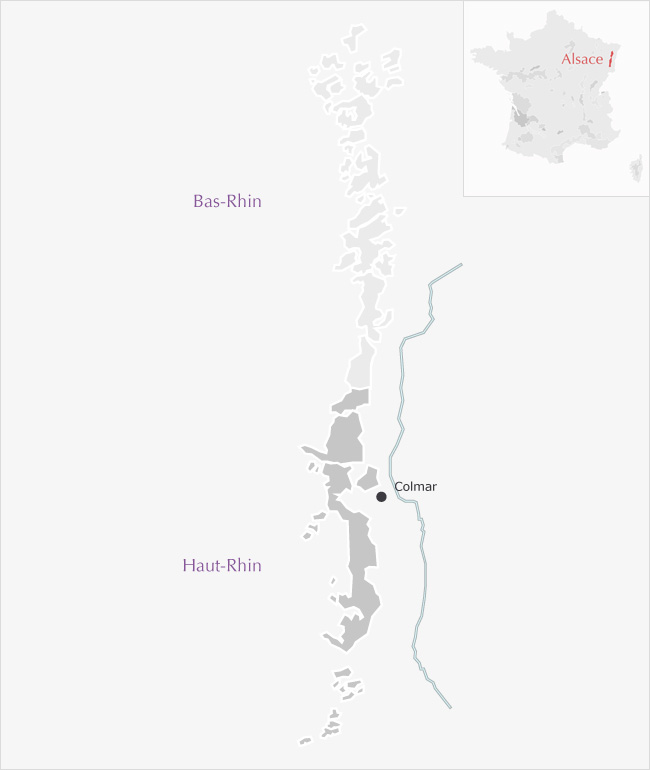France, a veritable showcase for the world's wine industry, is renowned for its richness and excellence in winemaking.
With a winemaking history that dates back to Roman times, France has influenced the world of wine through its viticulture and winemaking methods, as well as its wine classification. In this article, brought to you by Oeni your wine cellar management app available on iOS and Android, we'll explore France's major wine regions in detail, to understand what makes them so famous.
1. Burgundy: Land of Pinot Noir and Chardonnay

Located in eastern France, Burgundy is a wine-growing region made up of several appellations, offering a rich mosaic of terroirs. The region is world-renowned for its Chardonnay white wines and Pinot Noir reds. Vineyards are often very small plots, accentuating the diversity of the terroirs.
Chablis, Côte d'Or (itself divided into Côte de Beaune and Côte de Nuits), Côte Chalonnaise and Mâconnais are some of the most renowned sub-regions. Burgundy wines are renowned for their finesse, complexity and aging potential, offering a palette of flavors ranging from green apple and citrus for whites, to cherry, raspberry and spice for reds.
2. Bordeaux: Majestic capital of red wines

Located near the Atlantic coast in southwestern France, Bordeaux is arguably the country's most famous wine-growing region. Bordered by the Gironde, Dordogne and Garonne rivers, the region is divided into several sub-regions, including Médoc, Right Bank, Graves and Entre-Deux-Mers.
Bordeaux is best known for its red wines, often made from a blend of grape varieties, mainly Merlot and Cabernet Sauvignon, but also Cabernet Franc, Petit Verdot and Malbec. The region also produces excellent white wines, notably the sweet Sauternes. Bordeaux wines are renowned for their tannic structure, balance between acidity and fruit, and ability to age magnificently.
3. Champagne: Bulles de Prestige

Champagne, located in northeastern France, is world-famous for its eponymous sparkling wine. The dominant grape varieties are Pinot Noir, Pinot Meunier and Chardonnay. The region's cool climate contributes to the wines' acidity and finesse.
The méthode champenoise, or traditional method, involves a second fermentation in the bottle, which gives Champagne its fine, persistent bubbles. These wines are appreciated for their freshness, complexity and aromas of white fruit, brioche, hazelnut and flowers.
4. Rhône Valley: Diversity and Generosity

The Rhône Valley, stretching from south of Lyon to Avignon, is divided into two sub-regions: the northern Rhône, where Syrah is king, and the southern Rhône, dominated by Grenache. Viognier, Marsanne and Roussanne are the main white grape varieties in the north, while the south sees greater diversity with Ugni blanc, Bourboulenc and Grenache blanc, among others.
Prestigious appellations such as Côte-Rôtie, Hermitage, Châteauneuf-du-Pape and Gigondas make this region famous. Rhône wines are distinguished by their generosity, rich fruit and spice, and beautiful structure.
5. Alsace : A Bicultural Tradition

On the border with Germany, Alsace is characterized by its bicultural winegrowing tradition. Wines are predominantly white, from varieties such as Riesling, Gewurztraminer and Pinot Gris, but the region also produces Pinot Noir.
Alsace wines, often vinified dry, are renowned for their elegance, aromatic concentration and excellent acidity. They are often marked by notes of exotic fruit, flowers, honey and spices.
6. Loire: A palette of styles

The Loire Valley, with its majestic châteaux and verdant landscapes, is an extremely diverse wine-growing region. From the lively whites of Sancerre to the fruity reds of Chinon, from the sparkling wines of Saumur to the sweet wines of Coteaux du Layon, the Loire offers a wide variety of styles.
The main white grape varieties are Chenin Blanc and Sauvignon Blanc, while Cabernet Franc dominates the reds. Loire wines stand out for their freshness, purity of expression and, often, their excellent value for money.
In conclusion, France's wine-growing regions are distinguished by a diversity of terroirs, grape varieties and wine styles that never ceases to impress. It's this richness and diversity that has made France a benchmark in the world of wine. However, we mustn't forget other regions such as Beaujolais, Jura, Provence and Languedoc-Roussillon, which also make their own contribution to French viticulture.





